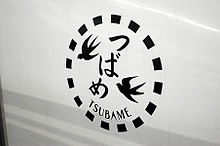Tsubame (train)
Tsubame ( Japanese 燕 , "swallow") was an express train of the Japanese Ministry of Railways , later the state railway , between the regions of Kantō and Kansai on the Tōkaidō main line , the most important modern transport link between eastern and western Japan at the time . It was one of the most important means of transport in the country before the Shinkansen was built .
The first Tsubame began operations in 1930 as a chō-tokkyū ( 超 特急 , "Super-Special-Express") between Tokyo and Kobe , for the entire route the train needed nine hours at an average speed of 67.5 km / h but faster than the Fuji , which previously connected Tōkyō with Osaka (from 1943 to Kyūshū, later as a night train until 2009). In 1937 the sister train Kamome started operating on the same route.
After the end of the Pacific War, an express train from Tōkyō to Osaka ran again from 1949 onwards from the now independent state railway, initially under the name Heiwa ( „, わ ," peace "), but from 1950 again as Tsubame (from now on using the Hiragana spelling つ ば め ). From 1950, the sister train Hato ( は と , "dove", before the war the name of an express train of the South Manchurian Railway between Dairen / Dalian and Chōshun / Changchun ) began operating on the same route . In 1956, when the entire Tōkaidō main line was electrified, the tsubame took seven hours and 35 minutes from Tōkyō to Osaka. The travel time fell further in the following years due to the use of new express train series. From 1962, when the San'yō main line to Hiroshima was electrified, the Tsubame drove the entire 900 km long route from Tōkyō to Hiroshima.
With the construction of the Tōkaidō Shinkansen, the loss of importance of the tsubame was foreseeable, but the "swallow" had established itself as a symbol of the Japanese state railway. The state railway's own baseball team has played as Kokutetsu Swallows since 1950 , and state railway buses used a swallow as their logo. After the opening of the Tōkaidō Shinkansen, the train was relocated to the continuing route from Shin-Osaka to Hakata , which it served until the 1970s. This route also received a high-speed connection through the San'yō Shinkansen : in 1975 the story of Tsubame ended (and Hato ) in the service of the state railway.
Resumption at the JR Kyūshū
The JR Kyūshū , one of the private successors of the state railway, also called some of its express connections Tsubame , initially an express train on the Kagoshima main line , and from the opening of the first section of the Kyūshū Shinkansen in 2004, a subsequent express connection, since 2011 the slowest, stopping at every station Kyushu Shinkansen line between Hakata and Kagoshima.
